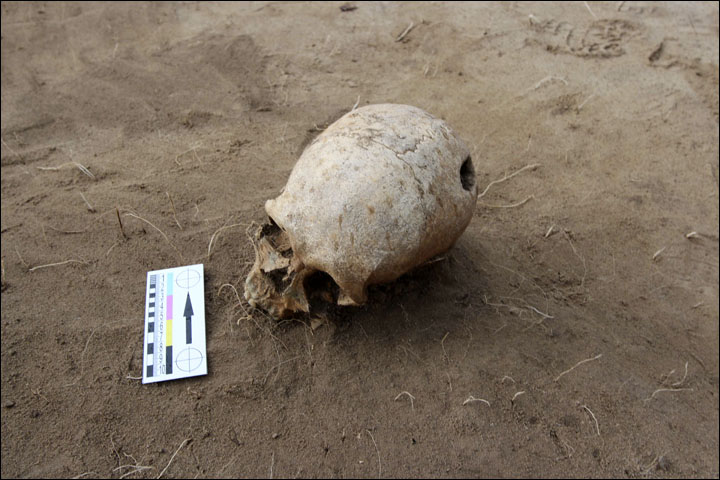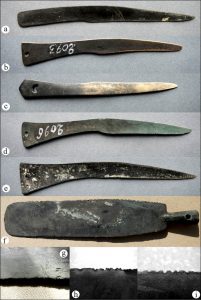“The key to successful surgery was the patient’s complete trust and confidence that the surgeon had the necessary skills and knowledge to carry out such an operation” – Dr. Sergey Slepchenko, a researcher at the Institute of Archaeology and Ethnography, Novosibirsk.

PHOTO: Siberian Times
KRASNOYARSK, SIBERIA – a male skull found in the Nefteprovod II burial ground at Anzhevsky archaeological site, just southeast of Kanask has been the subject of a year-long investigation looking into how Bronze Age medics managed to conduct brain surgery.
The skull found at Anzhevsky had a carefully-made hole that resulted from an early trepanation operation conducted on the ‘patient’ when he was about 30 or 40 years old.
“Trepanning” is a surgery where a hole is purposely made in the skull, usually to release cranial pressure. This is not the first instance of trepanning found in Siberia. One example dates all the way back to the Neolithic period.

PHOTO: Siberian Times
This surgery was conducted over 3,000 years ago. What interested the scientists working on the find the most was that it seems the patient actually survived and lived for some time after. The bone around the skull shows signs of healing, and there was evidence of an inflammatory reaction on the bone plates themselves.
They believe that he died as a result of a long-term inflammation around the brain caused by the surgery.
What they’re trying to figure out, though, is how the patient managed to even get through something like this without being put under.
The skull belongs to a man from the ancient Karasuk people or another similar people group. The Karasuk were a group of Bronze Age societies that lived around the Aral Sea, upper Yenisei, and the Altai Mountains around 1500-800 BC. They were farmers who were skilled metalworkers, and were the first people in Siberia to ride horses.
The trouble is that the plants commonly used as painkillers in other locations don’t exist in Siberia and would not have been available to the Shamanic doctors working on the patient. Dr. Sergey Slepchenko, who’s working on the investigation with a team of historians and researchers, was forced to take a long hard look at what was actually available for use in the area.
There’s actually quite a list.
Some ethnic groups in Siberia used thyme and juniper in their Shamanic practices. Others, such as the Nivkhi people, burned rosemary sticks and leaves. In the north, people used fly agaric mushrooms (Aminata muscarica) – a powerful psychoactive drug that induces euphoria, ataxia, and sometimes seizures and a long-lasting coma.
Of course, there’s also cannabis.

Examples of Siberian Bronze-Age surgical implements from the Minusinsky history museum [PHOTO: Siberian Times]
From there, Dr. Slepchenko gave a step-by-step process for how the surgery would have been conducted based on the shape and incline of the incision.
The surgeon stood face-to-face with the patient on his left side, or held his head with his left arm or between his knees and worked with his right hand. From there, he’d peel the layers away from the bone, and then carefully scrape away at the bone to make his incision.
He’d keep scraping until he’d expose the dura mater – the outer membrane that protects the brain and spinal cord. From there, he’d keep widening the hole to the desired size. He’d have to work quickly and carefully, and the wound wouldn’t be able to be closed normally.
The wound would be covered with skin, but it couldn’t be covered tightly, or they’d risk infection.
Archaeologists have no way of knowing whether or not the doctor stitched the wound up. They’re not sure how it was drained, either.
It was a risky, dangerous surgery.
“It is important that the dura mater remains intact since its damage may cause injuries to the…sinus located under its plates.” Slepchenko said. “To minimize bleeding and reduce pain, the operation had to be carried out as fast as possible by a presumably highly skilled surgeon.”
It’s unclear what tools were used in the surgery. Slepchenko believes it was definitely a scraper, not a knife.
The patient, amazingly, survived the surgery for some time until the wound became inflamed and infected – a common danger that simply came with the time period. Either way, the bone had started to heal, and it’s possible that, had the wound not become infected, the patient would have gone on to live several more years. It’s a testament to the skill of the surgeon and the trust of the patient, something that we normally don’t associate with a period as early as the Bronze Age.

